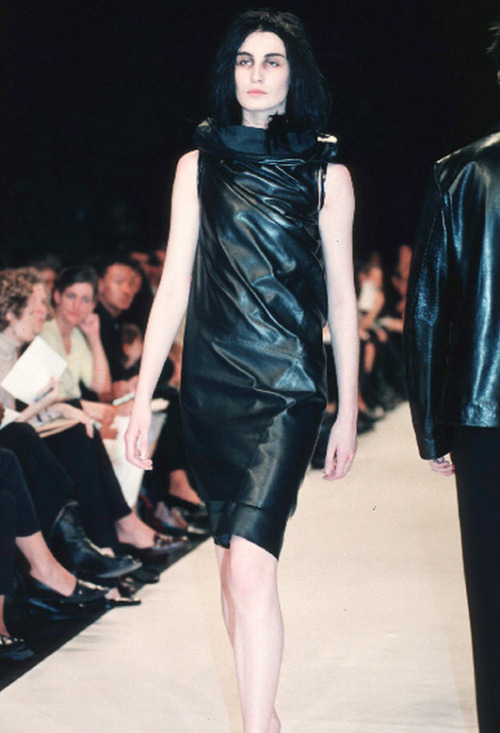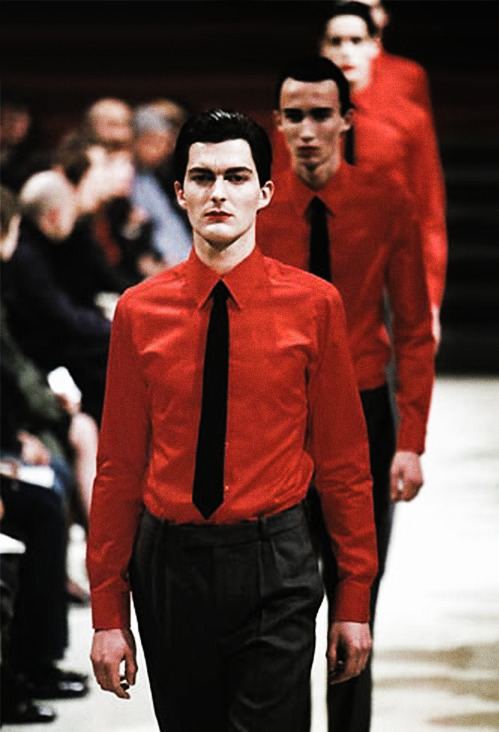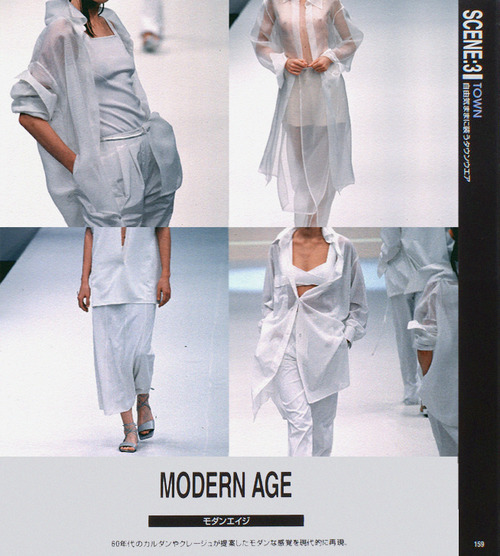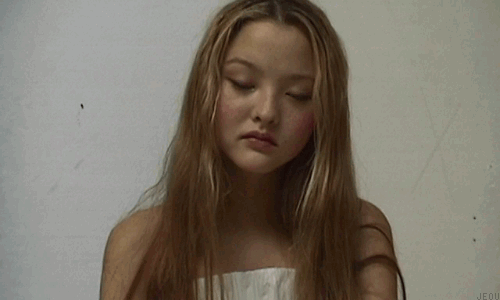 |
| The enchanting Devon Aoki for 'More Beautiful Women' |
Friday, 30 August 2013
MORE BEAUTIFUL WOMEN
The requirements to become a model seem generally straight-forward - striking beauty, unwavering professionalism and (most importantly), nerves of steel. By nominating themselves as clothes-horses, models are exposed to more scrutiny than any level of celebrity by the fashion press - every inch of a model's body is expected to be perfection, so the revealing 'More Beautiful Women' by respected fashion photographer Nick Knight provides a providing insight into the personalities behind the aesthetic. Before reading the rest of this post, feel free to click here - http://showstudio.com/project/more_beautiful_women to see the videos from the project in their entirety.
ARTCLOTHES
Many argue that art and fashion act in synchronicity with each other, whereas others reason that the two industries should exist in their own separate spheres and never intertwine. Recently, however, the influence of fine art in the world of fashion is becoming more and more ubiquitous - take Lady Gaga, for example, whose new album 'ARTPOP' features collaborations with artists such as Jeff Koons and Marina Abramovic alongside collaborations with fashion photographers Inez & Vinoodh. In addition, designers are increasingly beginning to cite artists as sources of inspiration for their work, none more so than Raf Simons who literally delved into the archives of Andy Warhol in order to create his latest collection for Christian Dior.
 |
| Detailed shot of the Warhol-inspired collection |
Wednesday, 28 August 2013
DEVON AOKI
Recently, there has been a surge in the popularity of supermodels - icons from the 90s are beginning to resurface as designers and magazines are looking for experience as opposed to youth. I have been fighting the urge to write about Devon Aoki for a while now, but with such a huge emphasis currently being placed on the women themselves as opposed to the clothing, I felt the time was right to feature a woman that has served as a muse for so many iconic avant-garde designers.
 |
| Devon Aoki in Alexander McQueen, by Nick Knight |
Thursday, 22 August 2013
SIMONE ROCHA
In the notoriously fickle fashion industry, competition for fresh faces to get noticed is stiffer than ever. However, one young designer is slowly emerging as a force to be reckoned with - despite her famous father (her father, John Rocha is head of his label 'Rochas' which is stocked in department stores worldwide), Simone Rocha is carving out her own name and her own aesthetic. Now on her seventh collection, the designer has gained recognition for her ability to play with texture, colour and print in order to create collections which lean towards a softer take on androgyny.
Tuesday, 20 August 2013
JOHN GALLIANO A/W 2009
After briefly mentioning this collection in the last post on Lady Gaga's 'Applause' video, I felt that this collection truly deserves further exploration. I have recently become more and more infatuated with Galliano as a designer - his creations for Dior Haute Couture were never anything short of spectacular, and a number of documentaries have been recently brought to my attention detailing the inspirations and the working processes of the eccentric genius. This collection is arguably one of his greatest - the show transitioned from structured jackets and full skirts through to sheer fabrics and explosions of organza, showcasing the full extent of Galliano's multi-faceted aesthetic.
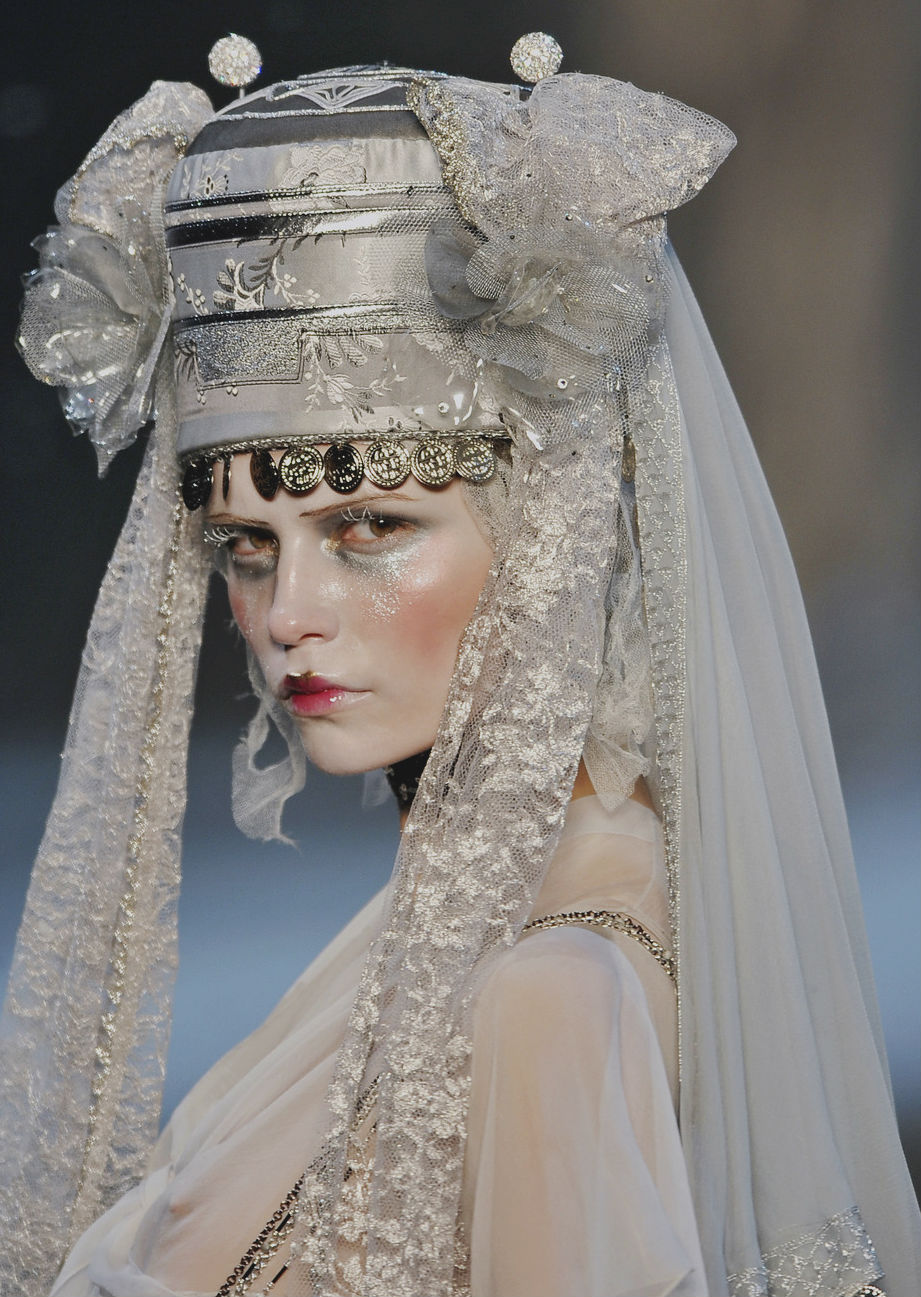 |
| Make-up, detail shot |
Monday, 19 August 2013
'APPLAUSE' - THE OUTFITS
It is no secret that Lady Gaga is beloved by the fashion industry. Designers such as the late Lee McQueen, Donatella Versace and Hussein Chalayan have all clamoured to dress her in the past, and she is good friends with elite fashion photographers such as Nick Knight and Inez & Vinoodh. Therefore, it comes as no surprise that Gaga's new video for her single 'Applause' is a fashion orgy of spectacular proportions. Featuring instantly recognisable designs by Gareth Pugh, John Galliano and Maison Martin Margiela, the singer pairs haute couture with D.I.Y creations from her own 'Haus' of Gaga in order to craft a truly memorable aesthetic. This blog post details some of the most eye-catching designs from the video alongside the collections that they came from.
Saturday, 17 August 2013
PART 7; BALENCIAGA
There have been a series of high-profile shake-ups in the fashion industry recently. It began with John Galliano's infamous anti-semitic rant which saw him replaced as creative director of Dior, and ended with Nicholas Ghesquière's decision to abandon his role at the helm of Balenciaga. In both cases it wasn't the departures that were startling, it was their chosen replacements that really grabbed headlines. The don of minimalism, Raf Simons, was chosen to take over Dior - a huge surprise considering that his streamlined approach to fashion design could not have been further from Galliano's dramatic, extravagant collections. After that, Balenciaga announced their decision to appoint Alexander Wang as their new creative director; a shocking decision, considering Wang's relative lack of experience. However, these two changes propelled the world of high-fashion into the realms of a chic new minimalism - by incorporating textural qualities and scarce prints, the two men are redefining the way that we look at clothes.
Wednesday, 14 August 2013
PART 6; CELINE
Minimalism in its various forms continued to dominate the fashion industry throughout the late 90s, but the new millennium marked a shift in interest. Designers such as Tom Ford for Gucci and Donatella Versace resumed their place at the top of the fashion food chain as society became more and more obsessed with celebrity culture and excess in general. The main form of advertisement for designers was the red carpet, and celebrities were determined to flash the flesh and flaunt their wealth. Minimalism was shunned in favour of an over-the-top aesthetic, and high-fashion became more sexualised and more extravagant. It was not until the later half of the decade that designers such as Marc Jacobs and Roland Mouret brought focus back to a streamlined silhouette, and it is arguable that minimalism was brought back into the mainstream thanks to the focus of one woman, Phoebe Philo.
 |
| Jumpsuit by Céline, editorial for Vogue |
In 2009 Philo was appointed as creative director of luxury French fashion house Céline, and from that point onwards the label went from strength to strength. Working with iconic photographers such as Juergen Teller, Philo managed to completely redress the brand's aesthetic and target a new audience - the twenty-something businesswoman. The new aesthetic was steeped in minimalism - from the muted colours to the simple silhouettes, the look was effortlessly stylish and instantly desirable.
Sunday, 11 August 2013
PART 5; DEMEULEMEESTER
This next post is all about one of fashion's cult icons, and another graduate of the iconic Antwerp fashion school that spawned giants such as Martin Margiela and Dries van Noten. Ann Demeulemeester's aesthetic is a fine example of a different brand of minimalism, a sort-of cross between grunge and elegance. Showing her first collection way back in 1989, it wasn't until the mid-to-late Nineties that Demeulemeester truly started to gain recognition for her work within the fashion community. Alongside houses such as Prada and Balenciaga, Demeulemeester focused on easy silhouettes and a monochrome palette but, instead of choosing the chic, streamlined accessories favoured by her contemporaries, Demeulemeester often completed the looks with chunky worker boots and home-made accessories.
The designer also had a tendency to work with rougher, edgier materials such as leather and PVC to engineer the look - one of the recurring themes within Demeulemeester's work is the contrast between hard and soft, and this is usually represented literally in the materials and silhouettes used, such as with the leather dress pictured above. The mid-Nineties were arguably the height of minimalism's popularity in high-fashion - at that time, Demeulemeester represented an element of choice, an alternative to the other sleek, more feminine incarnations of the look that were dominating the runways.
The designer also had a tendency to work with rougher, edgier materials such as leather and PVC to engineer the look - one of the recurring themes within Demeulemeester's work is the contrast between hard and soft, and this is usually represented literally in the materials and silhouettes used, such as with the leather dress pictured above. The mid-Nineties were arguably the height of minimalism's popularity in high-fashion - at that time, Demeulemeester represented an element of choice, an alternative to the other sleek, more feminine incarnations of the look that were dominating the runways.
Friday, 9 August 2013
PART 4; RAF SIMONS
It is not just womenswear in which the 'minimalist' aesthetic has dominated. After being inspired by Maison Martin Margiela's 'all-white' S/S 1991, Raf Simons decided to turn his hand to fashion design. Having previously studied in furniture design, the move was a bold one, but it was also a move that paid off as Simons established his own label in 1995. Choosing to street-cast his models, his first few collections were shown either in presentations or videos as opposed to runway shows; it was only in 1997 that he made his debut in Paris and won over the fashion world.
Thursday, 8 August 2013
PART 3; HELMUT LANG
Minimalism was generally at its peak during the late Eighties and early Nineties, and another pioneer of the movement was Austrian fashion designer Helmut Lang. Although he established his eponymous fashion house in 1986, it was only towards the early Nineties that his simple but elegant designs began to gain major recognition. Lang was interested in using hi-tec fabrics in order to introduce a cleaner, more futuristic incarnation of the minimalist aesthetic.
A lot of Lang's designs focused heavily around the use of various different shades of white, as well as the utilisation of layered sheer and opaque fabrics to create a textural quality. Texture in general was one of Lang's favourite elements - from looped woolen skirts to sequinned jackets and feathered skirts, there was usually an unconventional fabric choice that was subtly incorporated into an otherwise minimal look.
 |
| Shalom Harlow for Helmut Lang, F/W 1996 |
Tuesday, 6 August 2013
PART 2; MARGIELA
After the Japanese takeover of the early 80s came a new fashion movement, all of whose members were educated in Antwerp. Designers such as Dries van Noten, Walter van Beirendonck and Ann Demeulemeester made an impact on the international fashion scene but none of them more so than the enigmatic cult icon Martin Margiela. His 'Maison' showed its first collection in 1989, and the striking yet macabre use of only black, white and red would soon define his aesthetic as a designer - an aesthetic firmly rooted in minimalism.
The Belgian designers conceptual collections and reluctance to give interviews intrigued the mainstream media on a massive scale. His first runway show, for example, saw an army of masked models bathed in red paint before walking, leaving a trail of blood-red footprints on the white cotton of the runway which was then manufactured into a series of waistcoats. The models were always masked with plain black cotton - the obscurity of their identity meant that, in the era of the supers, the shows were truly about the clothing itself and Margiela's artistic statements as opposed to grabbing headlines for using big-name models.
 |
| Maison Martin Margiela S/S 1989 |
Monday, 5 August 2013
PART 1: YAMAMOTO
Despite first establishing his own label in Japan back in 1972, it was not until 1981 that Yohji Yamamoto made his international debut, showcasing the first collection of his eponymous label in Paris. The collection garnered massive amounts of column inches within the fashion press - in stark contrast to the body-conscious, high-glamour collections of the time, Yamamoto sent all of his models down the runway in black asymmetric clothing and dramatic white make-up. The use of loose fabrics, oversized silhouettes and a monochromatic colour palette would establish the aesthetic for which Yamamoto would become renowned; an aesthetic which the designer has experimented with and developed over his thirty-year career. The aesthetic was also the first consistent example of a 'minimal' collection, and was the first notable example of minimalism truly engulfing the mainstream and being seen as a more commercially viable option that traditional glamour.
Whilst the collection itself was interesting, it was the reaction of the fashion media that was the real talking point. The show marked the beginning of the 'Japanese invasion' and, essentially, a new era in fashion. Accompanied by Rei Kawakubo and Issey Miyake, the powerful trio baffled the media by creating designs that were deliberately designed to avoid being 'flattering'. The lines of the clothing never seemed to match the female form,and almost seemed to enshroud the figure rather than accentuate it. The collection was a feminist statement in some way - it showed that clothes could look good on a woman without being figure-hugging.
 |
| Yohji Yamamoto A/W 1996 |
MINIMALISM; 'THE MODERN AGE'
Over the past few seasons, the landscape of modern fashion has undergone a slight shift. After the huge demand for excess and glamour in the early Noughties saw designers such as Tom Ford and Donatella Versace rise to the top of the fashion food chain, consumers have recently started looking towards a more sleek, simple look. Perhaps it is due to the recession - the main argument here is that people are now only prepared to spend on designer clothing if they see a garment as an investment, therefore if an item is simple in design but high in quality then it is seen as more "timeless" than a trend piece. Another view is that the world has simply grown bored of high-glamour, especially considering that there can be a fine line between expensive and excessive, both in terms of price and design. No matter how we decide to rationalise it, it is undeniable that "minimalism" has been re-introduced to fashion in a major way, and thanks to designers such as Phoebe Philo, Raf Simons and Miuccia Prada, it looks set to dominate the wardrobes of the general public for the next few seasons.
The next few blogposts are dedicated to looking at the evolution of "minimalism" in all its forms. From the clean lines and loose tailoring of Japanese design through to the sharp structure and muted colours of designers such as Phoebe Philo and Helmut Lang, I will look at different examples of the concept and focus on the headstrong designers that helped establish the classic fashion mantra that less is more. The posts will be arranged in a vaguely chronological order, which is why the first post is dedicated to none other than the legendary Yohji Yamamoto. Alongside Rei Kawakubo, he helped to shift the focus of fashion from glamour to functionality - the reason that I have chosen to write about Yamamoto instead of Kawakubo is simply that Kawakubo's earlier collections had a tendency to focus on deconstruction as opposed to simplicity.
Thursday, 1 August 2013
CELINE BY JUERGEN TELLER
This week has seen a series of powerful fashion houses unleash advertising campaigns for their latest collections - from Adriana Lima at Miu Miu to Edie Campbell for Alexander McQueen, the variety of models, photographers and images used has been intriguing. This post is based on one of my all-time favourite campaigns, Céline's S/S 2010 collection, shot by Juergen Teller.
Dutch photographer Teller is renowned for his simple, humanist approach to photography. His images tend to be minimalist with little in terms of background, leaving the camera to focus entirely on subject. He has produced iconic images of supermodels such as Kate Moss and Devon Aoki, making him the perfect choice for the chic French fashion house.
Subscribe to:
Posts (Atom)



